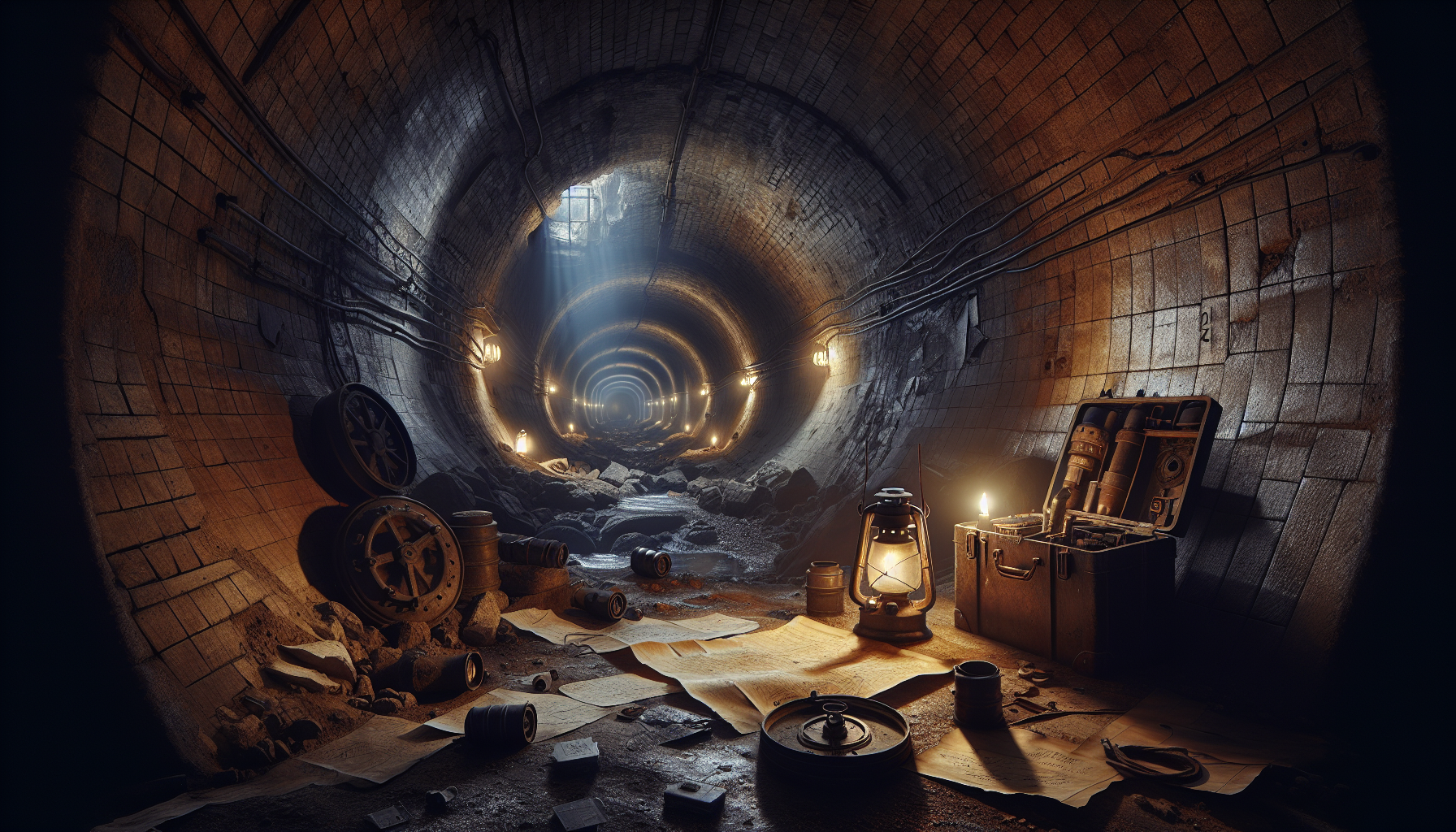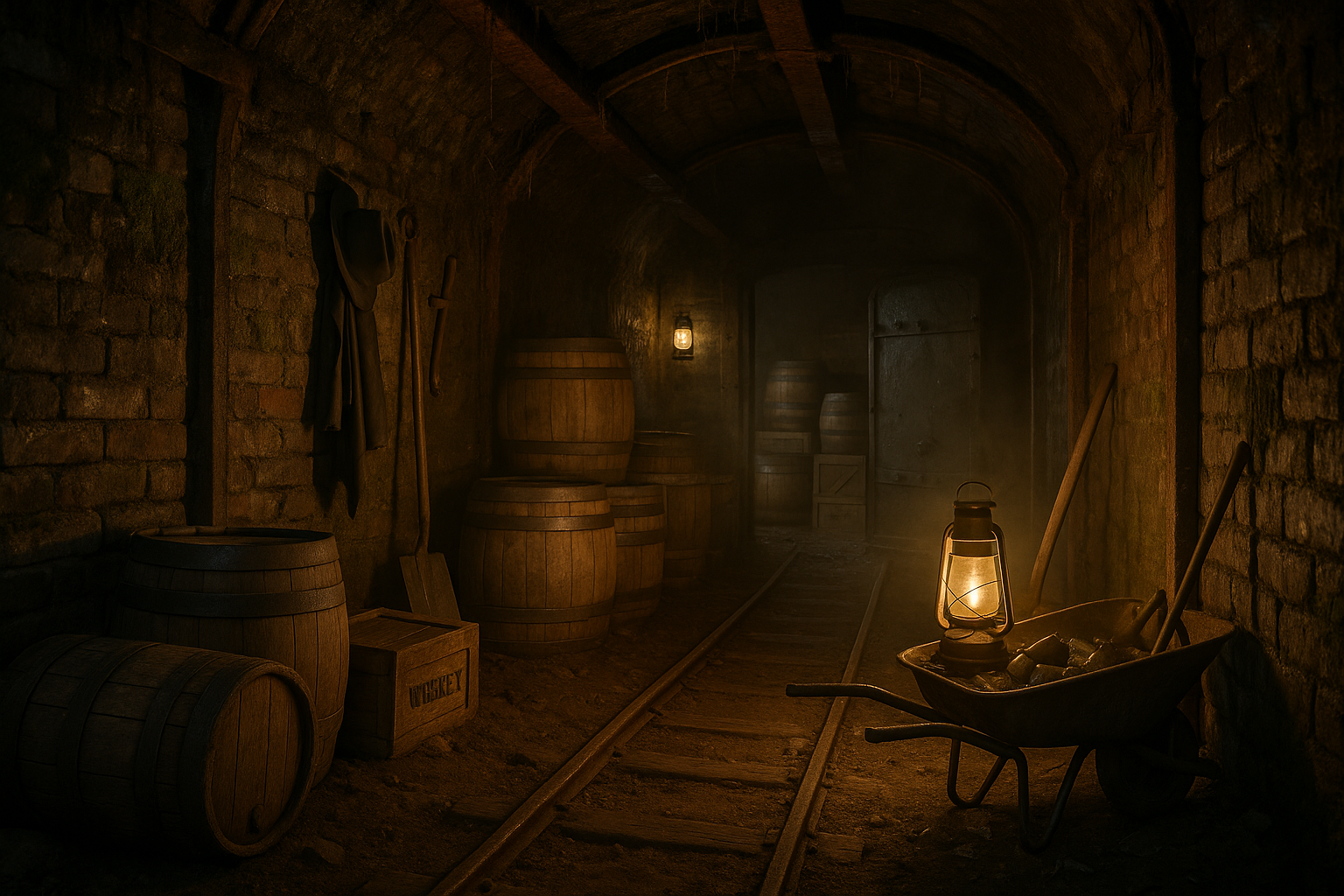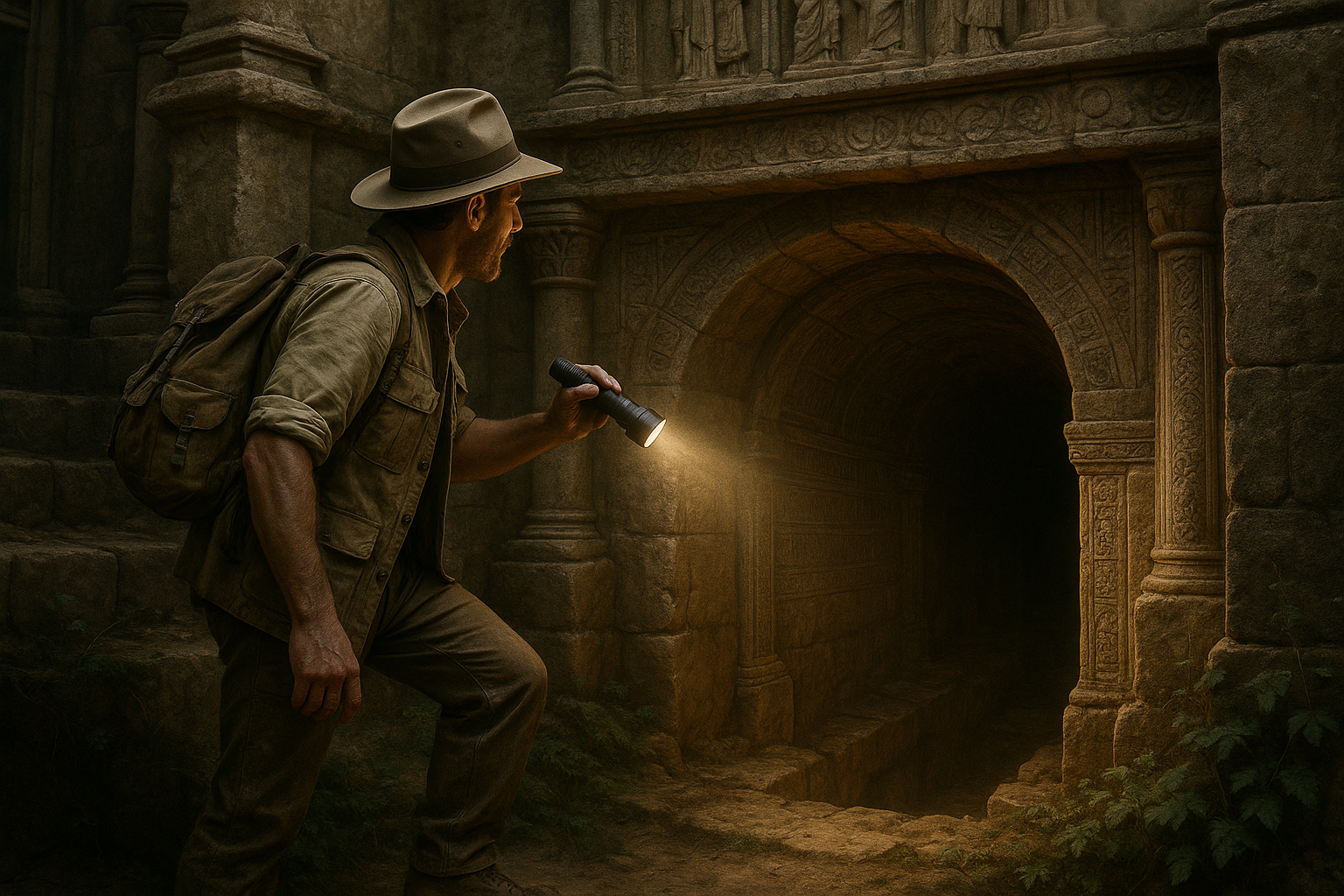In a world where technology reigns supreme, and cyber espionage seems to occupy the headlines, it’s easy to overlook the gritty, tactile roots of intelligence gathering that lie beneath our very feet. Imagine a realm where the shadows stretch further than the eye can see, where whispers are carried through echoing chambers of earth and stone. This is the hidden world of espionage tunnels—a world that thrives below ground, rich with history and intrigue. As we delve into this subterranean labyrinth, we uncover stories that are as complex and nuanced as the tunnels themselves, stories that remind us of the lengths to which nations and individuals will go to secure secrets. 🌍🔍
Throughout history, tunnels have been used as secret passageways for those daring enough to engage in espionage. From ancient times, when tunnels were mere rudimentary burrows in the ground, to the sophisticated, engineered structures of the modern age, these passageways have played a pivotal role in warfare and intelligence. Our journey begins by tracing the origins of tunnel warfare, examining how ancient civilizations used these underground passages to their advantage. Whether it’s the Assyrians undermining enemy walls or the Vietnamese employing intricate tunnel networks during the Vietnam War, the strategy has always been about gaining an unseen advantage over adversaries.
As we venture deeper into this world, we’ll explore the engineering marvels and the human ingenuity behind these tunnels. During the Cold War, for example, both the United States and the Soviet Union invested heavily in creating and discovering secret tunnels. The Berlin Tunnel, a remarkable feat of engineering, allowed American and British forces to tap into Soviet communication lines, offering a glimpse into the clandestine operations of espionage. But it wasn’t just about the technology; it was about the people—spies, engineers, and laborers—who risked everything to carve out these pathways to knowledge. 🤖🔧
The narrative of espionage tunnels is also a tale of human resilience and innovation. In the face of constant danger and the ever-present threat of discovery, those involved in these subterranean missions had to remain resourceful and adaptive. We’ll uncover stories of courage and betrayal, of alliances forged in darkness and rivalries that spanned continents. As we weave through the annals of time, you’ll meet figures who were instrumental in these underground operations, each with their motivations and moral dilemmas, adding layers of depth to this already complex narrative.
Finally, we’ll contemplate the future of espionage in an age where the digital seems to overshadow the physical. Are tunnels becoming obsolete, or is there still a place for these hidden pathways in modern intelligence operations? As we ponder these questions, we’ll reflect on the timeless allure of espionage tunnels—their ability to captivate our imaginations and their enduring role in the art of espionage. Join us as we descend into the earth, where every echo tells a story, and every shadow holds a secret. 🌑🕵️♂️
The Mysterious World of Espionage Tunnels
The clandestine nature of espionage has fascinated individuals for centuries, shrouded in secrecy and filled with intrigue. Among the various methods and tools employed by spies, the use of tunnels stands out as one of the most ingenious and elusive. These underground passageways have served as vital conduits for covert operations, allowing spies to move undetected beneath the earth’s surface. In this article, we will delve into the world of espionage tunnels, exploring their history, significance, and the extraordinary feats achieved through their construction and use.
Throughout history, tunnels have been employed for various purposes, from smuggling to military operations. However, the use of tunnels in espionage has taken on a unique significance. These subterranean pathways have allowed spies to bypass heavily guarded borders, smuggle sensitive information, and even facilitate daring escapes. The strategic advantage of tunnels lies in their ability to remain hidden from view, making them ideal for covert activities.
Historical Context of Espionage Tunnels
The history of espionage tunnels can be traced back to ancient times, when underground passages were used for military purposes. However, it was during the Cold War that espionage tunnels gained prominence as tools of intelligence gathering. This period, marked by intense geopolitical tensions between the Eastern and Western blocs, saw an unprecedented surge in espionage activities. Tunnels became a favored method for circumventing the heavily fortified borders and checkpoints that separated East and West.
During this time, both the United States and the Soviet Union invested heavily in tunnel construction as part of their intelligence efforts. The Berlin Tunnel, for instance, was a joint operation between the CIA and MI6, aimed at intercepting Soviet communications. The tunnel, stretching over 1,400 feet, was a marvel of engineering and a testament to the determination of intelligence agencies to gain the upper hand.
Another significant example is the Cu Chi Tunnels in Vietnam. While primarily used by the Viet Cong during the Vietnam War, these tunnels also served espionage purposes, allowing guerrilla fighters to conduct surveillance on enemy forces. The extensive network of tunnels, which stretched for miles, provided a strategic advantage in terms of mobility and stealth, crucial elements in both warfare and espionage.
Engineering Marvels: Constructing Espionage Tunnels
The construction of espionage tunnels is a complex and challenging endeavor, requiring meticulous planning and execution. Engineers and intelligence operatives work together to design tunnels that are not only functional but also virtually undetectable. The success of an espionage tunnel hinges on its ability to remain hidden from enemy surveillance and detection methods.
The process of constructing a tunnel begins with a detailed assessment of the terrain and soil conditions. Engineers must account for various factors, such as soil composition, groundwater levels, and potential obstacles, to ensure the tunnel’s stability and safety. Once the planning phase is complete, construction begins, often involving the use of specialized equipment and techniques to minimize noise and disturbance.
One of the key challenges in tunnel construction is maintaining secrecy throughout the process. This requires innovative approaches to disguise the operation, such as conducting construction at night or using cover stories to explain unusual activities. Additionally, advanced technology is often employed to monitor for signs of detection, allowing for quick adjustments if necessary.
Modern Espionage Tunnels and Their Impact
In the modern era, espionage tunnels continue to play a significant role in intelligence operations. Advances in technology have allowed for the development of more sophisticated tunnels, equipped with state-of-the-art surveillance and communication systems. These modern tunnels are designed to accommodate the latest intelligence-gathering tools, such as sensors and fiber-optic cables, enhancing their effectiveness.
Despite the technological advancements, the fundamental principles of tunnel construction remain largely unchanged. The emphasis on secrecy, precision, and engineering excellence continues to drive the design and implementation of these subterranean passageways. Modern espionage tunnels are often part of larger intelligence networks, working in conjunction with other covert methods to achieve strategic objectives.
Famous Espionage Tunnels and Their Stories
The history of espionage is replete with stories of daring and ingenuity, with tunnels often at the center of these narratives. Each tunnel has its own unique story, reflecting the creativity and resourcefulness of those involved in their construction and use. These stories serve as reminders of the high-stakes nature of espionage and the extraordinary lengths to which individuals and nations will go to achieve their goals.
One such story is that of the Tunnel of Eupalinos, an ancient Greek aqueduct tunnel that was repurposed for espionage during the Peloponnesian War. This tunnel, originally constructed to supply water to the city of Samos, was used by spies to infiltrate enemy territory and gather intelligence. The Tunnel of Eupalinos stands as an early example of how tunnels have been adapted for espionage purposes throughout history.
The Berlin Tunnel: Operation Gold
Operation Gold, also known as the Berlin Tunnel, remains one of the most audacious espionage operations of the Cold War. This joint venture between the CIA and MI6 involved the construction of a 1,476-foot tunnel beneath the border of East and West Berlin, allowing Western intelligence agencies to tap into Soviet communications.
The operation required immense planning and secrecy, with construction taking place over several months. Despite the tunnel’s success in intercepting valuable intelligence, the operation was eventually compromised, highlighting the risks and challenges inherent in such endeavors. The Berlin Tunnel serves as a testament to the boldness and ambition of Cold War espionage efforts.
Understanding the Legacy of Espionage Tunnels
The legacy of espionage tunnels is one of ingenuity and perseverance. These subterranean passageways have played a pivotal role in shaping the course of history, enabling covert operations that have had far-reaching implications. The stories of espionage tunnels continue to capture the imagination, serving as a reminder of the complex and often hidden world of intelligence.
In conclusion, espionage tunnels represent a fascinating intersection of engineering, strategy, and intrigue. From ancient Greece to the modern era, these underground passageways have been instrumental in the pursuit of intelligence and the protection of national interests. As technology continues to evolve, the role of tunnels in espionage will undoubtedly adapt, but their legacy as tools of secrecy and subterfuge will endure.
Exploring Espionage Tunnels in Popular Culture
Espionage tunnels have also captured the imagination of storytellers, finding their way into popular culture in various forms. From spy novels to movies, these tunnels serve as symbols of intrigue and mystery. Their inclusion in popular media highlights the enduring fascination with the clandestine world of espionage and the allure of hidden passageways.
One notable example is the film “Bridge of Spies,” which explores the tense dynamics of Cold War espionage and features references to tunnels and other covert methods. The film serves as a window into the high-stakes world of intelligence, offering audiences a glimpse into the challenges and triumphs of espionage operations.
For those interested in exploring the topic further, a video titled “The Berlin Tunnel: An Engineering Marvel of Espionage” on the National Geographic channel provides an in-depth look at the construction and significance of one of the most famous espionage tunnels. Watch the video to gain a deeper understanding of the intricacies involved in such a daring operation.
The Future of Espionage Tunnels
As we look to the future, the role of espionage tunnels is likely to evolve in response to advancements in technology and changes in geopolitical dynamics. The continued development of surveillance and detection methods will pose new challenges for those seeking to construct and utilize tunnels for covert purposes. However, the enduring appeal of tunnels as tools of espionage suggests that they will remain a vital component of intelligence operations.
In the coming years, we can expect to see increased innovation in tunnel design and construction, with a focus on enhancing their stealth and functionality. The integration of advanced materials and construction techniques will likely play a key role in shaping the future of espionage tunnels, allowing for more sophisticated and resilient underground networks.
Final Thoughts
The exploration of espionage tunnels reveals a world filled with mystery and intrigue, where the boundaries of human ingenuity are constantly pushed in the pursuit of intelligence. These tunnels stand as testaments to the creativity and determination of those involved in espionage, offering valuable insights into the complexities of covert operations.
For further exploration of this fascinating topic, consider diving into documentaries and books that delve deeper into the history and significance of espionage tunnels. The stories of these underground passageways continue to captivate audiences, serving as a reminder of the enduring allure of the world of espionage.
- Berlin Tunnel (Operation Gold)
- Cu Chi Tunnels in Vietnam
- Tunnel of Eupalinos
For an engaging overview, check out the table below comparing some of the most notable espionage tunnels:
| Tunnel Name | Location | Era | Purpose |
|---|---|---|---|
| Berlin Tunnel (Operation Gold) | Berlin, Germany | Cold War | Interception of Soviet communications |
| Cu Chi Tunnels | Vietnam | Vietnam War | Guerrilla warfare and espionage |
| Tunnel of Eupalinos | Samos, Greece | Ancient Greece | Water supply and espionage |

Conclusion
In conclusion, the intricate world of espionage tunnels, as explored in “Subterranean Secrets: Uncovering the World of Espionage Tunnels,” unveils a hidden dimension of intelligence operations that has captivated historians, scholars, and enthusiasts alike. Through a detailed examination of the historical context, technological advancements, and strategic significance of these clandestine passageways, we gain a deeper understanding of the lengths to which nations have gone to secure their secrets and gather vital information.
The article began by delving into the rich history of espionage tunnels, tracing their origins back to ancient civilizations where tunnels were used for both military and intelligence purposes. This historical perspective laid the groundwork for understanding how these subterranean structures have evolved over time, becoming more sophisticated with advancements in engineering and technology. By examining notable examples such as the Berlin Tunnel during the Cold War, we highlighted the strategic importance of these underground pathways in gathering crucial intelligence.
Technological advancements have played a pivotal role in the development of espionage tunnels, transforming them from rudimentary passages to highly sophisticated networks. The use of advanced materials, innovative construction techniques, and cutting-edge surveillance technologies has enabled intelligence agencies to create tunnels that are not only difficult to detect but also capable of withstanding various environmental challenges. This section underscored the ingenuity and resourcefulness of those involved in the construction and maintenance of these clandestine routes.
Furthermore, the strategic significance of espionage tunnels cannot be overstated. These covert conduits have been instrumental in facilitating communication, transportation, and the movement of resources across borders, often under the radar of enemy surveillance. By analyzing case studies from different geopolitical contexts, the article shed light on how these tunnels have shaped international relations and influenced the outcomes of various conflicts. The strategic value of espionage tunnels lies in their ability to provide a tactical advantage, allowing nations to gain the upper hand in intelligence gathering and covert operations.
The ethical and legal implications of using espionage tunnels were also explored, prompting a discussion on the moral dilemmas faced by intelligence agencies. The secrecy and deception inherent in tunnel operations raise questions about the balance between national security and the rights of individuals. This section encouraged readers to consider the broader implications of espionage activities and the responsibilities of those involved in safeguarding sensitive information.
As we conclude this exploration of espionage tunnels, it is crucial to recognize the ongoing relevance of this topic in today’s rapidly evolving geopolitical landscape. The lessons learned from historical examples continue to inform contemporary intelligence strategies, highlighting the enduring importance of innovation, adaptability, and secrecy in the world of espionage. The subterranean realm remains a potent symbol of the lengths to which nations will go to protect their interests and secure their futures.
In reflecting on the insights gained from this article, readers are encouraged to consider the broader implications of espionage tunnels in the context of modern intelligence operations. The themes of innovation, secrecy, and strategic advantage are not confined to the past; they continue to shape the dynamics of international relations and the pursuit of global security. By engaging with this topic, readers are invited to deepen their understanding of the complex interplay between technology, strategy, and ethics in the realm of espionage.
As we navigate an increasingly interconnected world, the lessons from espionage tunnels remind us of the importance of remaining vigilant, informed, and adaptable. The clandestine operations that unfold beneath our feet are a testament to the enduring quest for knowledge and power, driving nations to explore uncharted territories in their pursuit of security and influence.
We invite you, dear reader, to share your thoughts on the fascinating world of espionage tunnels. How do you perceive their role in shaping history and contemporary geopolitics? What ethical considerations do you believe should guide the use of such covert technologies? Engage with us by leaving a comment below, and don’t forget to share this article with others who might find this topic intriguing. 🌍🔍
For those interested in exploring further, consider visiting reputable sources such as the International Spy Museum for more information on the history and impact of espionage. Additionally, scholarly articles available through databases like JSTOR provide in-depth analyses of intelligence strategies and their implications.
Let us continue to explore the hidden narratives that shape our world, one subterranean secret at a time.
Toni Santos is a visual storyteller and artisan whose work explores the quiet power of what lies beneath. With a deep fascination for subterranean and hidden architecture, Toni uncovers the layers, voids, and forgotten spaces that shape our built environment from the shadows.
His art is a journey through the unseen — from ancient underground chambers to sealed passageways, service tunnels, and foundations buried in time. Each creation tells a story of silence, secrecy, and structure — revealing how absence and concealment can be just as meaningful as what’s visible above ground.
Whether working through visual compositions, architectural studies, or symbolic handcrafted pieces, Toni captures the soul of hidden spaces. His work bridges art and archaeology, blending design with discovery. Trained in visual design and traditional techniques, Toni creates with intention. His pieces don’t just depict — they interpret, inviting viewers to rethink what space, memory, and architecture mean when they’re hidden from view.
As the creative force behind Vizevex, Toni shares this perspective through curated visual narratives, symbolic collections, and interpretive essays that give voice to the quiet geometries beneath our feet.
His work is a tribute to:
The mystery of spaces built to be forgotten
The symbolism embedded in foundations, voids, and passageways
The timeless connection between human intention and hidden structure
Whether you’re an artist, an urban explorer, or someone fascinated by the unseen frameworks that support our world, Toni invites you into a realm where architecture becomes myth — one corridor, one layer, one buried story at a time.





